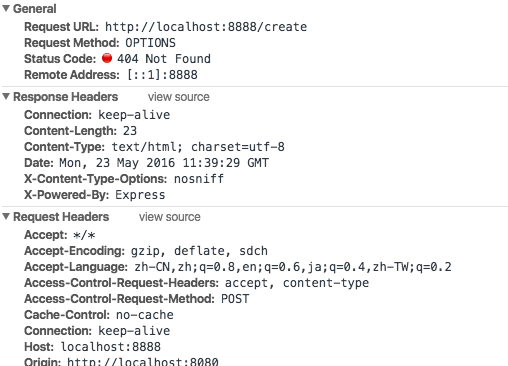(2/2)Vue构建单页应用最佳实战
前言
本章节,将会把所有的请求全写为跨域请求。不知道为什么,很多人一用了框架就会不知所措。给大家一个忠告,享受框架带来的便利,别忘了时刻提醒自己学好基础知识。
先把一些不必要的代码删了。
//TimeEntries.vue 的模拟数据代码 data () { // 模拟下初始化数据 /*let existingEntry = { comment: '我的第一个任务', totalTime: 1.5, date: '2016-05-01' }*/ return { timeEntries: [] } }, //头像和昵称暂时写死 <div class="col-sm-2 user-details"> <img src="https://avatars1.githubusercontent.com/u/10184444?v=3&s=460" class="avatar img-circle img-responsive" /> <p class="text-center"> <strong> 二哲 </strong> </p> </div> //LogTime.vue里的模拟数据代码 data () { return { timeEntry: { /*user: { name: '二哲', email: 'kodo@forchange.cn', image: 'https://sfault-avatar.b0.upaiyun.com/888/223/888223038-5646dbc28d530_huge256' },*/ } } }, 我们将专注3个字段的增删改查,任务时间,持续时间,备注。
正文
我们的数据交互其实很简单,所以我在这选择使用大家最熟悉的 express 和 mongodb ,在一个 app.js 文件里完成所有的 controller 。
首先,安装几个必要的包 npm i express mongodb morgan body-parser --save-dev;
简单解释下Morgan和body-parser,其实就是一个log美化和解析参数。具体大家可以google下。
在我们的根目录下,创建 app.js 初始化以下代码
//app.js var express = require('express'); var app = express(); var bodyParser = require('body-parser'); var morgan = require('morgan'); var MongoClient = require('mongodb').MongoClient; var mongoUrl = 'mongodb://localhost:27017/mission'; var _db; app.use(morgan('dev')); app.use(bodyParser.json()); app.use(express.static('dist')); MongoClient.connect(mongoUrl, function (err, db) { if(err) { console.error(err); return; } console.log('connected to mongo'); _db = db; app.listen(8888, function () { console.log('server is running...'); }); }); 解释下mongoUrl这行 mongodb://localhost:27017/mission 连接相应的端口,并且使用mission表。此时你是没有 mission 数据库的,这不用在意。在我们后续操作中,它将会自动创建一个mission数据库。
上面代码的意思是,我们创建我们的一个mongo连接,当数据库连接上了后再启动我们的服务器。
接着先启动我们的mongo服务。在命令行里 sudo mongo 。

如果你用得是webstrom编辑器,可以直接运行 app.js ,如果是命令行,那就使用 node app.js
如果看见命令行输出了 connected to mongo server is running... 就可以在 8888 端口访问我们的应用了。(在这之前别忘了build你的代码)
由于我们讲得是跨域,所以我们讲在我们的dev环境下完成所有的请求。 npm run dev
关闭我们的8888端口页面,进入8080端口的开发环境。
写下我们第一个创建任务的请求。
//app.js //使用post方法 app.post('/create', function(req, res, next) { //接收前端发送的字段 var mission = req.body; //选择一个表my_mission 此时没有没关系,也会自动创建 var collection = _db.collection('my_mission'); //如果我们需要的字段不存在,返回前端信息 if(!mission.comment || !mission.totalTime || !mission.date) { res.send({errcode:-1,errmsg:"params missed"}); return; } //如果存在就插入数据库,返回OK collection.insert({comment: mission.comment, totalTime: mission.totalTime,date:mission.date}, function (err, ret) { if(err) { console.error(err); res.status(500).end(); } else { res.send({errcode:0,errmsg:"ok"}); } }); }); 修改下我们的 LogTime.vue
//LogTime.vue <button class="btn btn-primary" @click="save()">保存</button> methods: { save () { this.$http.post('http://localhost:8888/create',{ comment : this.timeEntry.comment, totalTime : this.timeEntry.totalTime, date : this.timeEntry.date }).then(function(ret) { console.log(ret); let timeEntry = this.timeEntry console.log(timeEntry); this.$dispatch('timeUpdate', timeEntry) this.timeEntry = {} }) } } 输入好内容,点击保存按钮,会发现报了个错。这其实就是最常见的跨域请求错误。

 但是我们明明写得是
但是我们明明写得是 post 请求为什么显示得是 options 呢?
这其实是跨域请求前会先发起的一个 options 请求,需要先问问服务端,我需要一些操作可以吗?如果服务端那里是允许的,才会继续让你发送 post 请求。
我不知道那些使用 vue-resource 各种姿势也想满足跨域请求的人是怎么想的。想上天吗?
所以我们需要服务端配置,而不是前端。
//app.js app.all("*", function (req, res, next) { res.header('Access-Control-Allow-Origin', '*'); res.header("Access-Control-Allow-Headers", "Content-Type,Content-Length, Authorization, Accept,X-Requested-With"); res.header("Access-Control-Allow-Methods","PUT,POST,GET,DELETE,OPTIONS"); if (req.method == 'OPTIONS') { res.send(200); } else { next(); } }); Access-Control-Allow-Origin 是设置你的来源域名,写 * 是很危险的操作。所以我们可以直接写成我们所需的域名和端口,别人就没法请求了。
另外几行就不解释了,一看就懂。
不出意外,可以发现发送了options后,马上发送了post,然后就创建成功了。看下mongo的表,也多了一条记录。
接着来让我们一口气写完剩下的三个请求。列表渲染,删除计划,获取总时长。
//app.js var ObjectID = require('mongodb').ObjectID //获取总时长 app.get('/time', function(req, res, next) { //获取数据表 var collection = _db.collection('my_mission'); var time = 0; //查询出所有计划 collection.find({}).toArray(function (err, ret) { if(err) { console.error(err); return; } //所有计划累加时长 ret.forEach(function (item, index) { time += +item.totalTime; }); //返回时长 res.json({errcode:0,errmsg:"ok",time:time}); }); }); //获取列表 app.get('/time-entries', function(req, res, next) { var collection = _db.collection('my_mission'); collection.find({}).toArray(function (err, ret) { if(err) { console.error(err); return; } res.json(ret); }); }); //删除计划 app.delete('/delete/:id', function (req, res, next) { var _id = req.params.id; var collection = _db.collection('my_mission'); console.log(_id) //使用mongodb的唯一ObjectId字段查找出对应id删除记录 collection.remove({_id: new ObjectID(_id)} ,function (err, result) { if(err) { console.error(err); res.status(500).end(); } else { res.send({errcode:0,errmsg:"ok"}); } }); }); 前端部分
//App.vue ready() { this.$http.get('http://localhost:8888/time') .then(function(ret) { this.totalTime = ret.data.time; }) .then(function(err) { console.log(err); }) }, //TimeEntries.vue route : { data(){ this.$http.get('http://localhost:8888/time-entries') .then(function(ret) { this.timeEntries = ret.data; }) .then(function(err) { console.log(err); }) } }, //TimeEntries.vue <div class="col-sm-1"> <button class="btn btn-xs btn-danger delete-button" @click="deleteTimeEntry(timeEntry)"> X </button> </div> deleteTimeEntry (timeEntry) { // 删除 let index = this.timeEntries.indexOf(timeEntry) let _id = this.timeEntries[index]._id if (window.confirm('确认删除?')) { this.$http.delete('http://localhost:8888/delete/' + _id) .then(function(ret) { console.log(ret); }) .then(function(err) { console.log(err) }); this.timeEntries.splice(index, 1) this.$dispatch('deleteTime', timeEntry) } } 完结
到此,我们就将我们整个应用完成了。新增创建删除都可用了。
本来还想有上传头像等,那样觉得更多的是偏后端教学。既然我们是vue的简单入门教程就不过多介绍。
本系列让大家轻松的了解学习了vue,vue-router,vue-resource,express,mongodb的运用。
还是那句话,享受框架带来便利的同时,别忘了加强基础的训练。基本功才是真正的王道啊。玩电竞的玩家一定深有体会。
最后给有兴趣的同学留下两个简单的作业1.完成头像昵称的字段 2.完成修改操作
源码地址: https://github.com/MeCKodo/vue-tutorial
(1/2)Vue构建单页应用最佳实战 http://div.io/topic/1701











![[HBLOG]公众号](https://www.liuhaihua.cn/img/qrcode_gzh.jpg)

